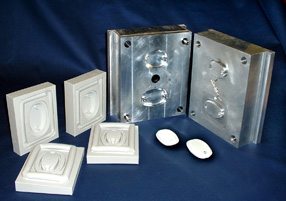中文
ENGLISH
中文
ENGLISH
Injection Molding is one of the most common ways to manufacture your product in production. The first step is choosing a tooling option that works for your project. Here are 8 questions from actual customers that will help make it a little easier to choose your Injection Mold Tooling.

This is the probably the most important factor in determining which tooling method to use.
If the part is for pre-production then the answer is simple, aluminum tooling. This is common when the project requires the part to be made with the end production vowin.cn/' target='_blank'>injection vowin.cn/' target='_blank'>mold material. Aluminum tooling offers lower costs and faster lead times. If the material requirement is not needed see alternative options on RTV Molding and 3D Printing.
If the part is for production then there are a couple things to consider. What are the EAUs on the part? How long will the project run?
Part size plays a big factor in determining tooling. Larger parts will need to be built in a standalone tool however smaller parts that fit within the size parameters may be subject to a (more efficient) cheaper alternative. Insert tools are extremely popular for smaller components. Instead of paying the full price of a standalone tool we can look to build an insert tool that fits into the (standard MUD) base unit on our press.
For example, you have a small housing that is 3″x 2″x 1/2″ and needs to be produced via Injection Molding. Instead of building a full standalone tool for such a small part we will build an insert tool out of aluminum or steel that fits into our pre-existing bases on our press. This is an extremely economical and waste minimization method to produce smaller components. We offer insert sizes ranging from a 5″x 5″ all the way up to a 11″x 14″.
Part volumes can effect tooling especially when the volumes reach a higher level. The standard is a single cavity tool for low volumes of a couple hundred or a couple thousand parts per year, but as the part volumes grow you can look to add multiple cavities on the tool to produce parts more economically. When quantities and life of project are unknown or there is no solid forecast, single cavity tools are a good place to start. You can always look at building multi-cavity tools later on. Multiple cavity tools come with a little more upfront cost on the tool but it can significantly lower the piece price on your part.
Does part material effect tooling?
Yes, it does. The part material has direct effect on tooling for a couple of reasons. Mild injection mold resins like a Polypropylene are a lot easier on a mold therefore contributing to a longer tool life. Harsher injection mold resins like a Glass Filled Nylon wear down a tool much easier. This can be a crucial deciding factor when your part has a life of 8,000-12,000 pieces and you are deciding between aluminum or steel tooling.
Yes, it does. We thoroughly evaluate each part before quoting. We look at part features that will effect the tool. Does it have undercuts? Cores? We also look at surface finish requirements. Will it be grained? Polished? Textured? These all effect the decision on the type of tooling used.
Aluminum tools are good for a lifespan of anywhere from 2,000- 10,000 parts depending on the type of aluminum used, part material and geometry.
Steel tools are good for a lifespan of 100,000 + parts depending on the material and geometry of the part. The tool may need re-worked after it has been in production for awhile.
This changes on a part by part basis but a good rule of thumb would be:
Aluminum tools can be built in anywhere from 4-6 weeks for small parts and 6-10 weeks for larger parts while steel tools can be built in anywhere from 6-8 weeks for small parts and 8-12 weeks for larger parts.
This also changes on a part by part basis but typically a steel tool costs anywhere from 20-30% more then an aluminum tool.


